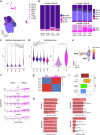Exosome-based targeted delivery of NF-κB ameliorates age-related neuroinflammation in the aged mouse brain
- PMID: 39833561
- PMCID: PMC11799301
- DOI: 10.1038/s12276-024-01388-8
Exosome-based targeted delivery of NF-κB ameliorates age-related neuroinflammation in the aged mouse brain
Abstract
Neuroinflammation, a significant contributor to various neurodegenerative diseases, is strongly associated with the aging process; however, to date, no efficacious treatments for neuroinflammation have been developed. In aged mouse brains, the number of infiltrating immune cells increases, and the key transcription factor associated with increased chemokine levels is nuclear factor kappa B (NF-κB). Exosomes are potent therapeutics or drug delivery vehicles for various materials, including proteins and regulatory genes, to target cells. In the present study, we evaluated the therapeutic efficacy of exosomes loaded with a nondegradable form of IκB (Exo-srIκB), which inhibits the nuclear translocation of NF-κB to suppress age-related neuroinflammation. Single-cell RNA sequencing revealed that these anti-inflammatory exosomes targeted macrophages and microglia, reducing the expression of inflammation-related genes. Treatment with Exo-srIκB also suppressed the interactions between macrophages/microglia and T and B cells in the aged brain. We demonstrated that Exo-srIκB successfully alleviates neuroinflammation by primarily targeting activated macrophages and partially modulating the functions of age-related interferon-responsive microglia in the brain. Thus, our findings highlight Exo-srIκB as a potential therapeutic agent for treating age-related neuroinflammation.
© 2025. The Author(s).
Conflict of interest statement
Competing interests: C.C. is the founder and shareholder of ILIAS Biologics, Inc. The remaining authors declare no competing interests.
Figures






References
-
- Dong, Y. et al. Single-cell and spatial RNA sequencing identify perturbators of microglial functions with aging. Nat. Aging2, 508–525 (2022). - PubMed
MeSH terms
Substances
Grants and funding
LinkOut - more resources
Full Text Sources
Medical

